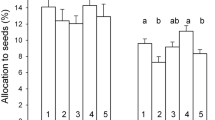Abstract
Plasticity in fitness components including seed weight and seed number and fitness-related traits including biomass, plant height, leaf area, and reproductive allocation at various organization levels in response to low- and high-nutrient patches was examined in the tillering grass Panicum miliaceum. Plants were planted in boxes consisting of two patches, the central patch (CP) and surrounding patch (SP), with each containing soil with either low or high nutrients. Nutrient status of the CP and contrast between the CP and SP significantly affected root performance, leaf photosynthesis and turnover, and growth and allocation. The effects of nutrient status of the CP and contrast between the CP and SP on the fitness and fitness-related traits differed between the ortet (the original organism from which a clone was derived), tiller, and genet, suggesting that patchy soil nutrients might have different effects on plasticity in the fitness and fitness-related traits at various levels, or even at the same level. Seed weight and seed number of a genet increased with increasing leaf mortality and leaf natality, respectively. Individual seed weight of the genet was restricted by that of the ortet and tiller together, whereas the number of seeds of the genet was determined mainly by the total number of seeds of the tillers. It is inferred that reallocation of genet-leveled fitness to the ortet and tillers may be beneficial to lower and spread risk of whole genet, and that plasticity in the fitness may help whole genet better adapt to variable environments.
Similar content being viewed by others
References
Alpert P. 1999. Effects of clonal integration on plant plasticity in Fragaria chiloensis. Plant Ecol. 141: 99-106.
Berendse F., de Kroon H. and Braakhekke W.G. 1999. Acquisition, use, and loss of nutrients. In: Pugnaire F.I. and Valladares F. (eds), Handbook of functional plant ecology. Marcel Dekker, Inc., New York, USA, pp. 315-340.
Bradshaw A.D. 1965. Evolutionary significance of phenotypic plasticity in plants. Adv. Genet. 13: 115-155.
Casper B.B. and Cahill J.F. 1998. Population-level responses to nutrient heterogeneity and density by Abutilon theophrasti S(Malvaceae): An experimental neighborhood approach. Am. J. Bot. 85: 1680-1687.
DeWitt T.J., Sih A. and Wilson D.S. 1998. Costs and limits of phenotypic plasticity. Trends Ecol. Evol. 13: 77-81.
Dong M. 1995. Morphological responses to local light conditions in clonal herbs from contrasting habitats, and their modification due to physiological integration. Oecologia 101: 282-288.
Donohue K., Messiqua D., Pyle E.H. and Heschel M.S. 2000. Evidence of adaptive divergence in plasticity: Density-and site-dependent selection on shade-avoidance responses in Impatiens capensis. Evolution 54: 1955-1968.
Eriksson O. and Jerling L. 1990. Hierarchical selection and risk spreading in clonal plants. In: van Groenendael J. and de Kroon H. (eds), Clonal growth in plants: regulation and function. SPB Academic Publishing, The Hague, the Netherlands, pp.79-94.
Farley R.A. and Fitter A.H. 1999. The responses of seven co-occurring woodland herbaceous perennials to localized nutrientrich patches. J. Ecol. 87: 849-859.
Fransen B., de Kroon H. and Berendse F. 1998. Root morphological plasticity and nutrient acquisition of perennial grass species from habitats of different nutrient-availability. Oecologia 115: 351-358.
Harper J.L. 1985. Modules, branches, and the capture of resources. In: Jackson J.B.H., Buss L.W. and Cook R.E. (eds), Population biology and evolution of clonal organisms. Yale University Press, New Haven, Connecticut, USA, pp. 1-33.
He W.M. and Dong M. 2001. Root growth of the annual tillering grass Panicum miliaceum in heterogeneous nutrient environments. Acta Bot. Sin. 43: 846-851.
Hendricks J.J., Nadelhoffer K.J. and Aber J.D. 1993. Assessing the role of fine roots in carbon and nutrient cycling. Trends Ecol. Evol. 8: 174-178.
Humphrey L. and Pyke D.A. 1997. Clonal foraging in perennial wheatgrasses: A strategy for exploiting patchy soil nutrients. J. Ecol. 85: 601-610.
Jackson R.B. and Caldwell M.M. 1993. The scale of nutrient heterogeneity around individual plants and its quantification with geostatistics. Ecology 74: 612-614.
Jackson R.B., Mooney H.A. and Schulze E.-D. 1997. A global budget for fine root biomass, surface area, and nutrient contents. Proc. Natl. Acad. Sci., USA 94: 7362-7366.
van Kleunen M., Fischer M., Schmid B. 2000. Costs of plasticity in foraging characteristics of the clonal plant Ranunculus reptans. Evolution 54: 1947-1955.
Lincoln R., Boxshall G. and Clark P. (eds), 1998. A dictionary of ecology, evolution, and systematics (Second edition). Cambridge University Press, Cambridge, UK, p. 213.
Mordelet P., Barot S. and Abbadie L. 1996. Root foraging strategies and soil patchiness in a humid savanna. Plant Soil 182: 171-176.
Reynolds J.F., Virginia R.A., Kemp P.R. and de Soyza A.G. 1999. Impact of drought on desert shrubs: Effects of seasonality and degree of resource island development. Ecol. Monogr. 69: 69-106.
Robinson D. 1994. The responses of plants to non-uniform supplies of nutrients. New Phytol. 127: 635-674.
SAS. 1985. SAS/STAT Guide for Personal Computer. 6th edition. SAS Institute Inc., Cary.
Schlesinger W.H., Raikes J.A. and Hartley A.E. 1996. On the spatial pattern of soil nutrients in desert ecosystems. Ecology 77: 364-374.
Turkington R., Hamilton R.S. and Gliddon C. 1999. Within-population variation in localized and integrated responses of Trifolium repens to biotically patchy environments. Oecologia 86: 183-192.
Wijesinghe D.K. and Hutchings M.J. 1999. The effects of environmental heterogeneity on the performance of Glechoma hederacea: The interaction between patch contrast and patch scale. J. Ecol. 87: 860-872.
Author information
Authors and Affiliations
Corresponding author
Rights and permissions
About this article
Cite this article
He, WM., Zhang, H. & Dong, M. Plasticity in fitness and fitness-related traits at ramet and genet levels in a tillering grass Panicum miliaceum under patchy soil nutrients. Plant Ecology 172, 1–10 (2004). https://doi.org/10.1023/B:VEGE.0000026043.27342.e2
Issue Date:
DOI: https://doi.org/10.1023/B:VEGE.0000026043.27342.e2




